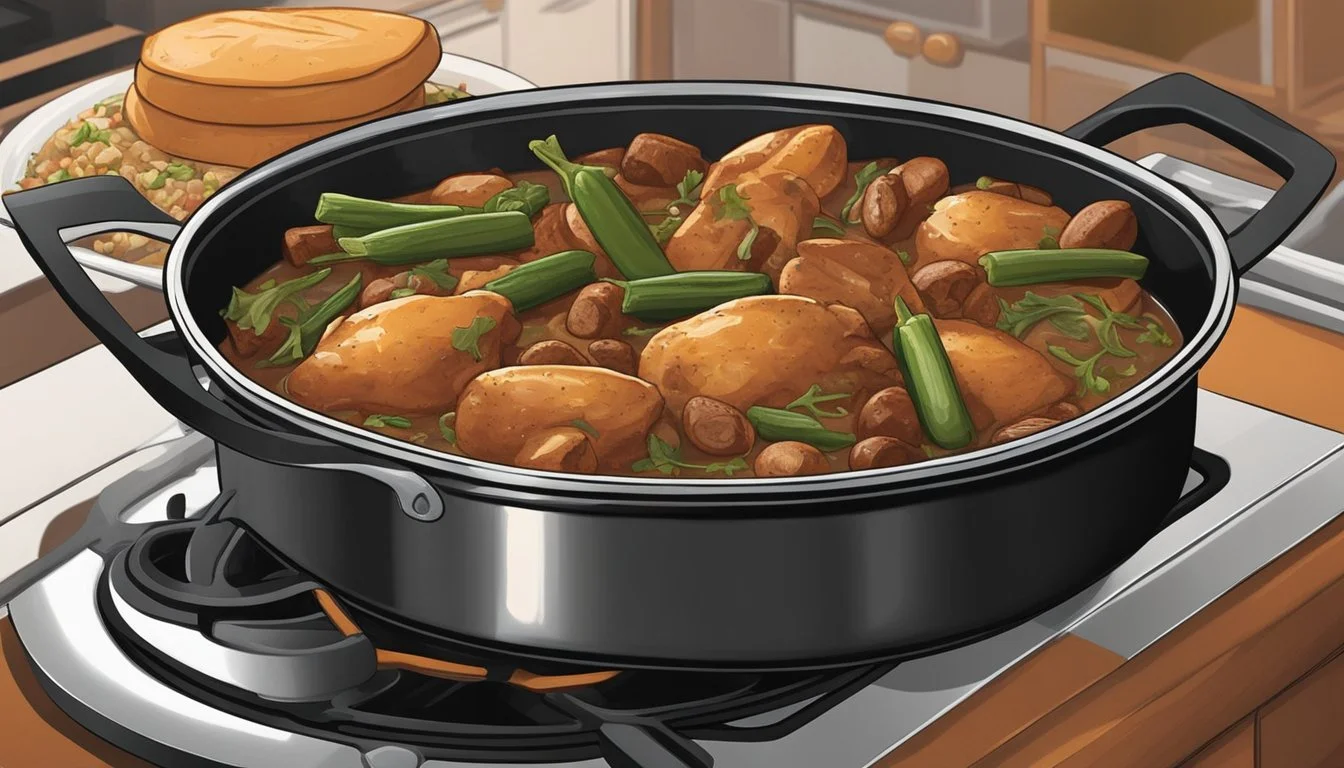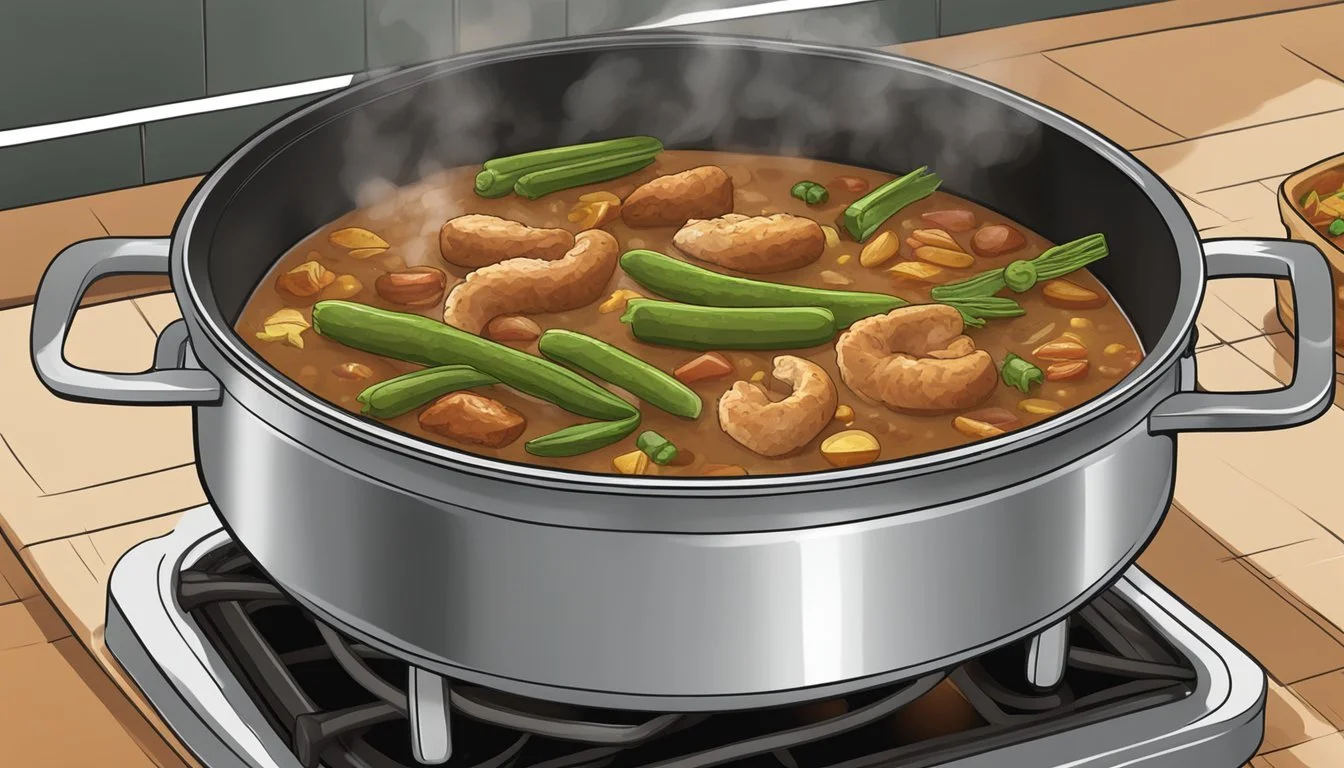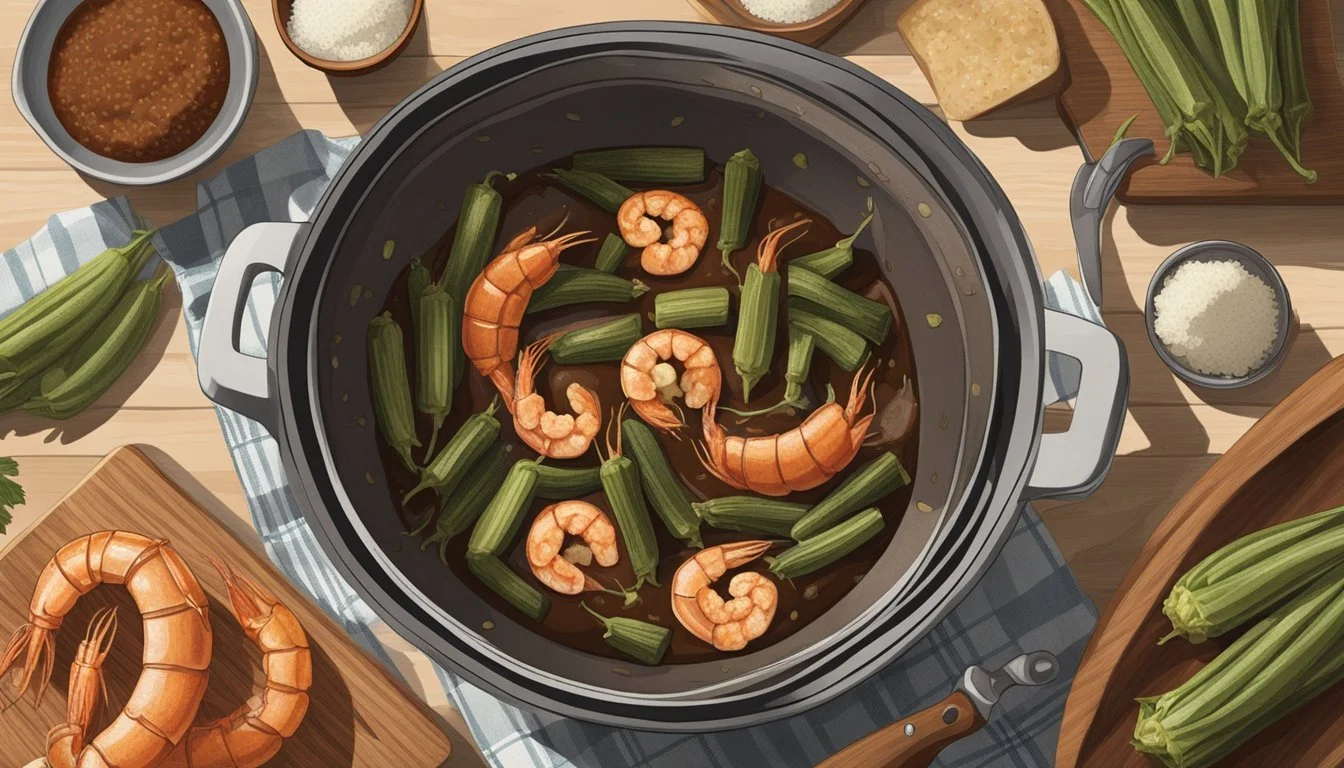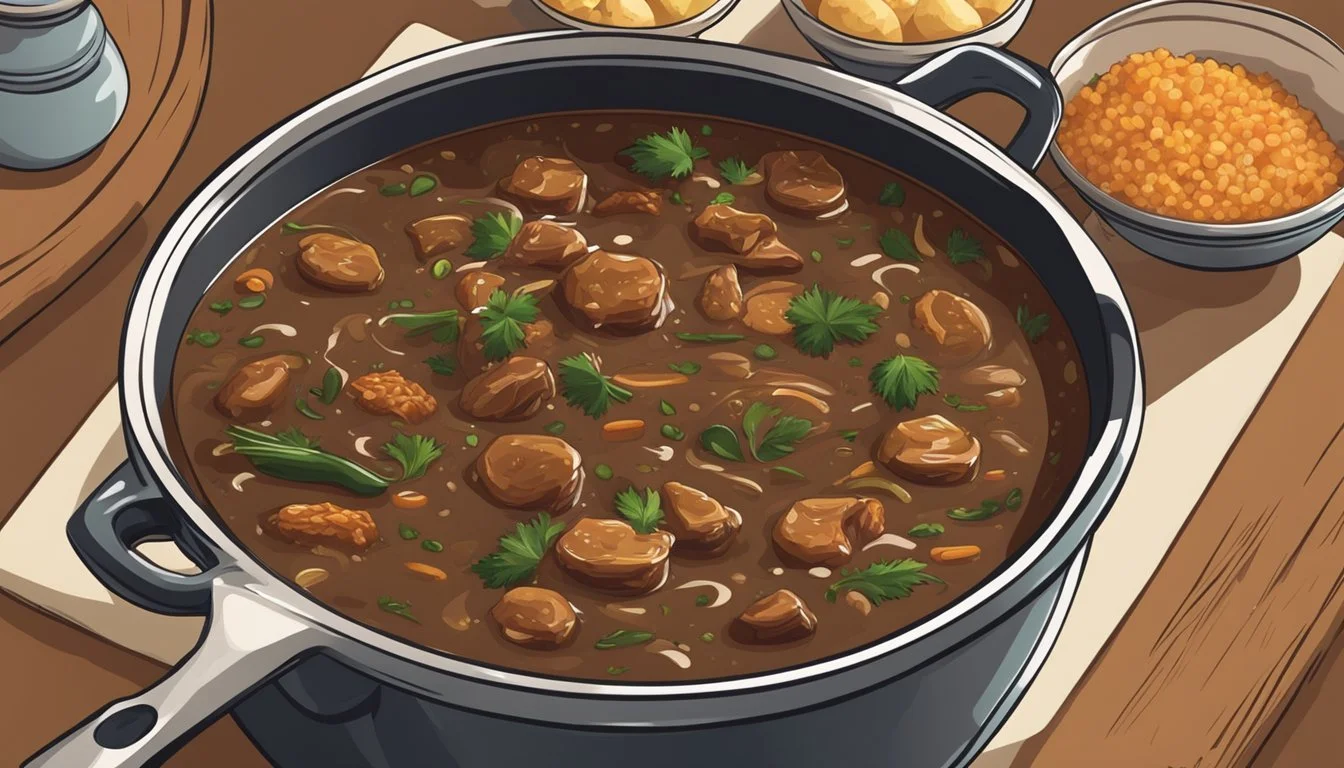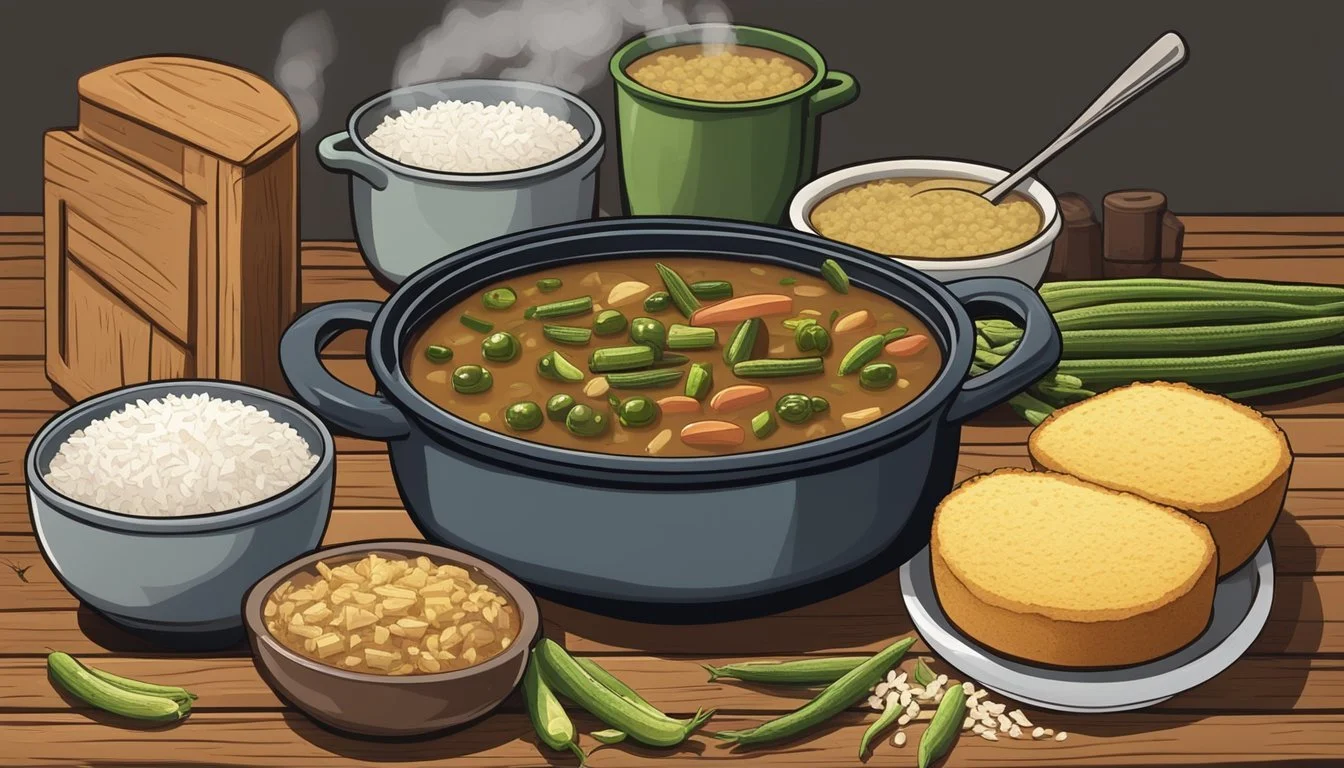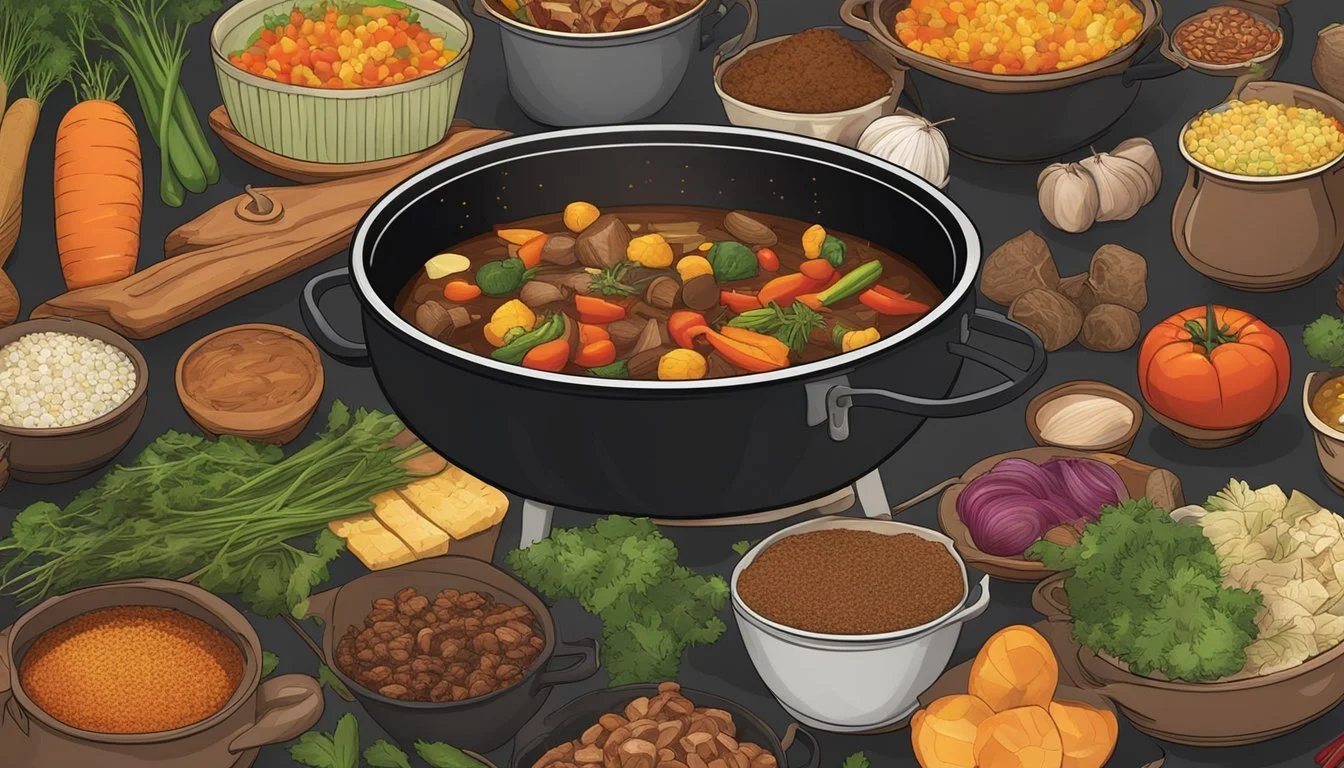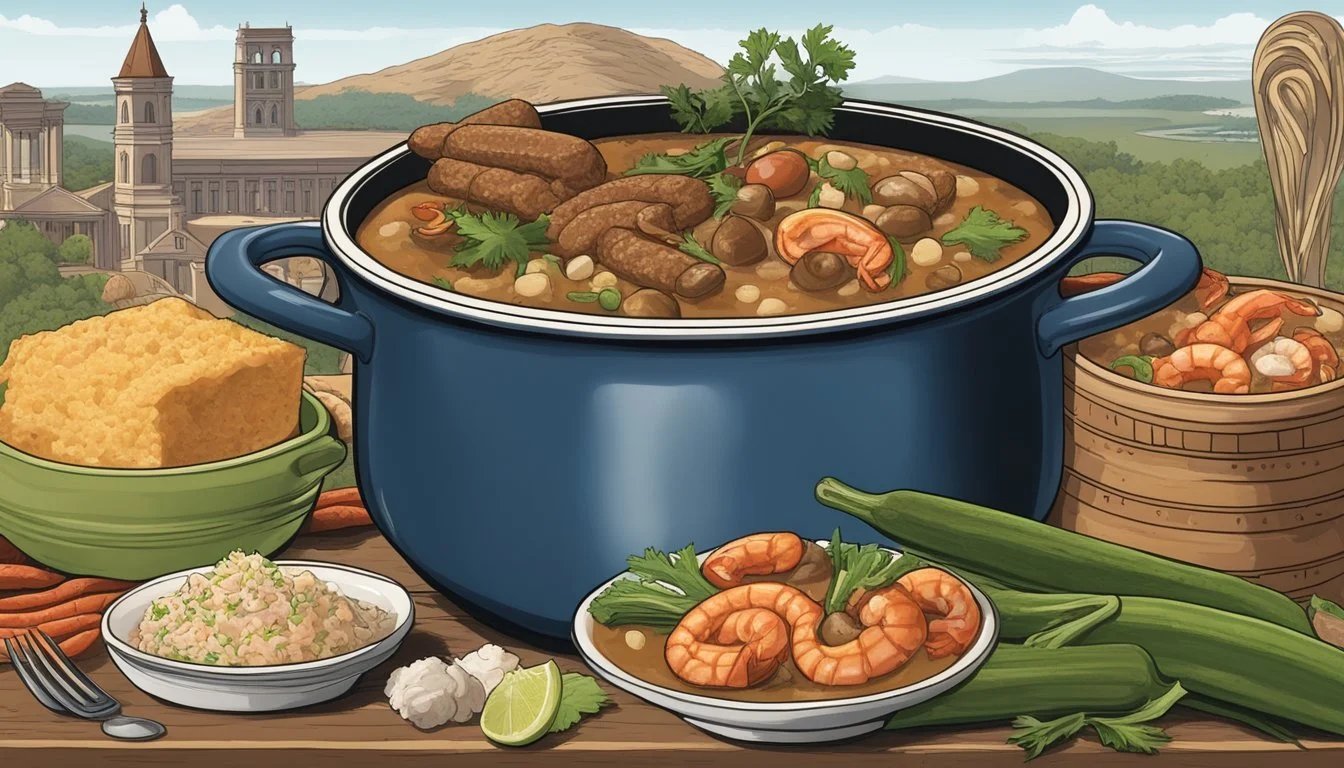How to Prepare a Texas-Style Gumbo
Your Ultimate Guide
Gumbo, a dish steeped in Southern tradition, finds a distinctive twist in Texas. This hearty stew typically combines robust flavors and a variety of textures, bringing together meats, vegetables, and a thickening base to create a comforting meal. Texas-style gumbo often incorporates local ingredients and preferences, such as spicier sausages and a preference for certain meats, like chicken or shrimp, which align with the Lone Star State's love for bold flavors and hearty portions.
In preparing Texas gumbo, cooks start with a foundation of aromatic vegetables and a roux, which imparts a rich flavor and thickens the stew. The roux, a mixture of flour and fat cooked to the desired color, ranges from blonde to deep brown and is critical for achieving the classic gumbo consistency. The "holy trinity" of onions, celery (how long does celery last?), and bell peppers, sautéed until tender, creates a flavorful base for the addition of meats and spices, which simmer and meld together to form the gumbo's complex flavor profile.
A well-made Texas gumbo is a reflection of both a cook's skill and the cultural amalgamation that is a trademark of the region. With its layers of flavor developed through slow cooking, a good gumbo can set the stage for family gatherings or serve as a showpiece in a festive celebration. Despite the many variations, the essence of Texas gumbo lies in its ability to bring people together, sharing in a dish that is as full-bodied and spirited as Texas itself.
Essentials of Gumbo
Traditional gumbo is a rich culinary representation of the diverse cultural influences in Louisiana, including African, Spanish, and French heritages. Its complexity is a testament to this mosaic of flavors and techniques.
Understanding Gumbo
Gumbo is a staple dish hailing primarily from Louisiana, often associated with Creole and Cajun cuisines. A quintessential comfort food, gumbo typically consists of a strong-flavored stock, a thickener, and the Holy Trinity of vegetables, namely celery, bell peppers, and onions. Meats or shellfish are also essential to its hearty texture.
The thickener is a poignant example of cultural fusion: a roux made from cooking flour and fat together, echoing French culinary practices. Alternative thickeners include okra, an African introduced ingredient, and filé powder, made from the ground leaves of the sassafras tree, which is an element borrowed from Native American traditions.
Popular Gumbo Variations
Various adaptations of gumbo exist, each with its own local spin. The most common variations encountered include:
Cajun Gumbo: Generally spicier, made with a dark roux, and often contains chicken and andouille sausage. It might exclude tomatoes, which is a point of contention amongst culinary enthusiasts.
Creole Gumbo: Besides the usual trinity and roux, it typically includes tomatoes, which reflects the influence of Spanish and French gastronomy. Seafood is a prominent feature in Creole variations, with shrimp and crab (how long does crab last?) frequently gracing the pot.
Despite regional variations, Texans have embraced gumbo and adapted it with local ingredients and flavors, hence the Texas-Style Gumbo, often heartier and integrating meats like smoked sausage or brisket, showcasing Texas's renowned barbeque tradition.
Preparation Basics
Preparing a Texas-style gumbo begins with understanding the ingredients and the equipment needed for the process. Mastery of these basics ensures a rich and flavorful gumbo that embodies the essence of Texas cuisine.
Ingredients Breakdown
The foundation of a Texas-style gumbo lies in its ingredients: a balance of meats, vegetables, and spices. Here is a breakdown:
Meats: Hearty proteins such as chicken and sausage are central. They should be sautéed to develop a deep flavor.
Vegetables: The "holy trinity" of onion, celery, and green bell pepper provides the aromatic base, with garlic enhancing the depth of flavor.
Seafood: Shrimp may be included, bringing a characteristic Gulf Coast touch to the dish.
Okra: Acts as a thickening agent and is a traditional element in gumbo.
Rice: Served alongside or mixed into the gumbo, rice absorbs the rich flavors.
Oil & Flour: Combined to create a roux, which is critical for thickening and flavor.
Seasoning: Salt and black pepper, with bay leaves for an aromatic presence.
Category Ingredients Meats Chicken, Sausage Base Vegetables Onion, Celery, Green Bell Pepper, Garlic Optional Seafood Shrimp Thickening Agents Okra, Flour (for roux) Seasoning Salt, Black Pepper, Bay Leaves Accompaniment Rice
Required Cooking Equipment
To prepare Texas-style gumbo, the right equipment makes all the difference:
Large Soup Pot or Dutch Oven: Essential for sautéing and simmering the gumbo.
Skillet: For browning meats evenly.
Stirring Utensil: A wooden spoon is ideal for stirring the roux and gumbo without scratching cookware.
Cutting Board and Knife: Necessities for prepping vegetables and meats.
Measuring Tools: For all ingredients, precision matters.
Equipment Use Large Soup Pot/Dutch Oven Main cooking vessel Skillet For browning meats Wooden Spoon Stirring roux and gumbo Cutting Board & Knife Prepping ingredients Measuring Tools Ensuring ingredient precision
Gathering quality ingredients and the proper equipment are the first steps to crafting an authentic Texas-style gumbo that is both satisfying and true to its roots.
Creating the Foundation
The foundation of a Texas-style gumbo lies in crafting a robust roux and preparing a flavorful base with the holy trinity of vegetables.
Making the Roux
To start, one needs a thickener known as a roux, which is a combination of fat and flour. For a traditional Texas gumbo, use equal parts of all-purpose flour and fat. The choice of fat can vary between butter and cooking oils, but canola oil is a popular option due to its neutral flavor and high smoke point. In a heavy-bottomed pot, she must heat the oil over medium heat before gradually sprinkling in the flour, stirring constantly to prevent the flour from burning. This mixture is cooked to a rich, dark color, which could take around 15 to 20 minutes, to develop a deep flavor base.
Ingredients for Roux
All-purpose flour
Canola oil or butter
Steps
Heat canola oil in a heavy pot on medium heat.
Gradually add all-purpose flour, stirring constantly.
Cook until the mixture reaches a deep brown color.
Preparing the Holy Trinity
Once the roux is ready, the next step is to prepare the "holy trinity," a cornerstone in Cajun and Creole cooking, consisting of onions, bell peppers, and celery. This trio is finely chopped and then sautéed in the roux until the vegetables are tender and the aroma is fragrant. The ratio is typically two parts onion to one part celery and one part bell pepper. They are a critical element of the base, adding both flavor and substance to the gumbo.
Ingredients for Holy Trinity
Onions
Celery
Bell peppers
Steps
Finely chop the vegetables maintaining the ratio (2:1:1).
Sauté in the roux until they are tender and aromatic.
The Cooking Process
Crafting a Texas-style gumbo involves a thoughtful approach to cooking meats and simmering the stew to achieve a flavorsome and hearty dish, enriched by a symphony of seasonings and garnishments, that pays homage to its Southern roots.
Cooking the Meats
In the first phase, the meat—often a combination of pieces of chicken and andouille sausage—is browned to perfection. In a dutch oven or large soup pot, chicken pieces are seasoned, typically with Cajun seasoning, and then sautéed until golden brown. This not only adds depth to the flavor but also helps in sealing the juices. The sausages are similarly treated, until they have a rich color and are partially cooked through, before being set aside.
Simmering the Gumbo
A well-prepared broth serves as the backbone of any gumbo. For Texas-style gumbo, chicken stock is commonly utilized as the base. The stock is brought to a boil and then reduced to a simmer, allowing the broth to thicken gradually. It's during this simmering stage, which lasts around 30 to 45 minutes, that the gumbo begins to develop its complex layers of flavor.
Adding Seasonings and Garnishments
The final flourish involves a liberal application of seasonings and garnishments. Traditional Cajun and Texan ingredients such as thyme, cayenne, and Worcestershire sauce are stirred in, their quantities carefully measured to achieve a balance between heat and flavor. For an authentic touch, gumbo filé is often sprinkled in just before serving, while chopped parsley adds a fresh contrast to the rich and savory stew. This detailed seasoning process is pivotal, as it brings out the characteristic Cajun gumbo essence and rounds out the dish.
Final Touches and Serving
When the robust simmering of the Texas-style gumbo has done its work, it's time to give the dish its quintessential finishing touches and move on to the presentation. At this stage, the gumbo is almost ready to charm the palates of those waiting eagerly at your table.
Integrating File Powder
As the cooking process concludes, one final and crucial ingredient that should be incorporated is filé powder. This fine powder, made from dried and ground sassafras leaves, acts as a thickener and imparts a subtle, earthy flavor to the gumbo. It is recommended to turn off the heat and then stir in approximately one teaspoon of filé powder per quart of gumbo. Doing this off the heat prevents the filé powder from becoming stringy, instead allowing it to evenly disperse throughout the gumbo.
Serving Recommendations
A classic bowl of Texas-style gumbo is incomplete without a generous scoop of cooked white rice. To serve, place a mound of rice in the center of each bowl and ladle the gumbo around it. The ideal ratio is about 1/2 cup of cooked rice to 1-1.5 cups of gumbo, ensuring every spoonful includes a taste of the flavorsome broth, rich meats, vegetables, and the rice.
For those who enjoy an added zest, additional gumbo filé can be offered at the table, allowing guests to adjust the thickness and flavor to their liking. Remember, a confident presentation of the nuanced complexities of this renowned Southern dish will solidify its hearty welcome to any gathering.
Accompaniments and Side Dishes
Creating the perfect Texas-style gumbo experience extends beyond the main dish. It involves selecting the right side dishes that complement the flavors and textures of the traditional gumbo. These sides should balance the hearty and spicy nature of the gumbo without overshadowing it.
Traditional Sides
Rice: A staple with gumbo, rice serves as a base that helps absorb the rich sauce and supports the complex flavors. White long-grain rice is most commonly used.
Cornbread: A southern classic, cornbread offers a sweet and crumbly texture that contrasts nicely with the spicy and savory notes of gumbo.
Potato Salad: This cold, creamy side dish provides a refreshing contrast to the warmth of gumbo, often featuring potatoes, mayo, mustard, and vegetables.
French Bread: Crispy on the outside and soft on the inside, French bread is perfect for sopping up the flavorful broth that's signature to gumbo.
Hush Puppies: These deep-fried cornmeal balls are slightly sweet and serve as an excellent complement to the rich and hearty gumbo.
Side Dish Description Why They Work with Gumbo Rice White long-grain rice Absorbs flavors and adds texture Cornbread Sweet, crumbly bread Balances out spice and adds a contrasting sweet note Potato Salad Cold dish with creamy dressing Provides a palate-cleansing contrast French Bread Crusty outside with a fluffy center Ideal for soaking up gumbo's savory broth Hush Puppies Sweet, fried cornmeal treats Adds a textural contrast to the dish
Pairing these sides with Texas-style gumbo elevates the meal, ensuring a symphony of tastes and textures that are sure to satisfy.
Advanced Techniques and Variations
Advanced techniques in preparing Texas-Style Gumbo include adding distinctive ingredients and embracing local culinary innovations to enhance the traditional recipe, creating a richer and more complex dish.
Incorporating Unique Ingredients
In a Texas-Style Gumbo, one can diversify the profile of flavors and textures by including a variety of proteins and seafood. Essential to the depth of flavor is the smoked sausage, typically using Texas smoked links that provide a robust taste. The addition of crab (What wine goes well with crab?) and crabmeat is considered gourmet, giving the gumbo a luxurious twist. Fresh or pre-cooked crabmeat can be gently stirred into the gumbo before serving to maintain its delicate texture. For those preferring a briny flavor, oysters are an exquisite choice; they should be added in the last 10 minutes of cooking to prevent overcooking.
Texas-Style Gumbo Innovations
Texas chefs often experiment with traditional recipes, infusing them with local flair. A signature innovation includes adding a hearty Texas beer to the stock, enhancing the richness of the roux and introducing subtle malty notes. One might also encounter pickled okra as a garnishing asset, offering a tangy contrast to the simmered flavors. Moreover, some variations replace rice with a scoop of cheesy jalapeno grits for a Southern twist, marrying the gumbo’s savory taste with a creamy, spicy kick.
Storage and Make-Ahead Tips
When creating Texas-Style Gumbo, understanding the proper storage methods for both short-term and long-term keeps the dish fresh and flavorful, while reheating techniques ensure every serving is as good as the first.
Proper Storage Methods
Storing: For short-term storage, one should place the cooled gumbo in an airtight container and store it in the refrigerator, where it remains safe to eat for 3 to 4 days. To extend the shelf life, freezing is a viable option.
Refrigerator: Store gumbo in an airtight container for 3-4 days.
Freezing:
Cool the gumbo completely.
Transfer to freezer-safe bags or containers.
Label with the date and freeze for up to 3 months.
Make-Ahead: For those eager to prepare ahead, making the roux beforehand can be a time-saver. After cooling, store it in a sealed container or resealable bag, removing as much air as possible.
Reheating Procedures
When reheating, one should aim for even heating without altering the gumbo's rich texture and flavor.
From Refrigerator:
Transfer the desired amount to a pot.
Reheat on the stove over medium heat until hot, stirring occasionally.
From Freezer:
Thaw overnight in the refrigerator.
Transfer to a pot and reheat as above.
One should adjust seasonings after reheating, as flavors may mellow during storage. Heating on a stove is preferred to microwaving to maintain the integrity of the gumbo’s texture and ingredients.
Nutritional Information
When preparing Texas-style gumbo, it's important to consider the nutritional content of the dish, as the ingredients can vary widely.
Health Considerations
Texas-style gumbo often incorporates a variety of protein sources such as chicken, sausage, and sometimes seafood. Here's a breakdown of key nutritional components found in a typical serving:
Calories: The caloric content can range significantly depending on the ingredients used. For instance, sausage and meats add to the calorie count, whereas more vegetables and lean meats like chicken breast can reduce it.
Proteins: Gumbo can be a good source of protein, especially if it includes chicken, beef, or seafood.
Fats: The fat content is largely influenced by the type of oil used in the roux and the cuts of meat. Opting for leaner meats and being mindful of the roux can manage fat levels.
Carbohydrates: Rice, a common accompaniment to gumbo, increases the carbohydrate content of the meal.
Fiber: Vegetables like onions, celery, and bell peppers contribute to the dish’s fiber content.
Vitamins and Minerals: Seafood or beef options provide iron and B-vitamins, while the vegetables in gumbo offer various vitamins and antioxidants.
It's important for individuals with dietary restrictions or health concerns to adjust the recipe accordingly to meet their nutritional needs. For instance, a roux made with whole wheat flour can increase fiber content, while using less rice or substituting it with cauliflower rice can reduce carbohydrate intake for those on lower-carb diets. Gumbo can also have high sodium levels, especially when using store-bought broths and seasonings, so one might consider homemade alternatives or low-sodium options.
Regional Influences
Texas-style gumbo brings together a rich tapestry of flavors influenced by both the local bounty and cultural heritage of the region.
East Texas and Cajun Country
In East Texas, where the traditions of the South blend with the state's own cowboy culture, gumbo is as much a gathering point as it is a dish. With the close proximity to Louisiana's Cajun Country, there's an undeniable influence from across the state border. Local chefs and home cooks incorporate the "holy trinity" of Cajun cooking—celery, bell peppers, and onions—which forms a robust base that embodies the heartiness of the region.
Cajun Country, spanning across the Gulf of Mexico and into parts of Louisiana, has bestowed upon East Texas a penchant for spice and depth of flavor. The Cajuns’ French-Canadian roots coupled with the incorporation of local ingredients such as Andouille sausage and seafood from the Gulf, result in a gumbo that's rich and characteristically full-bodied. East Texas gumbo often features a dark roux, indicative of a nod towards Cajun influence, which imparts a boldness that can be tempered by the serving of rice.
Houston, as a culinary hub, stands out in East Texas with its ability to fuse various influences into regional favorites. The gumbo here might pick up hints from its proximity to both Cajun Country and the Gulf of Mexico, leading to a flavorful pot where shrimp and crab from the Gulf are frequent stars of the dish. Additionally, Houston’s diverse population contributes to a gumbo scene that can include less traditional but equally celebrated versions, encompassing a broad spectrum of tastes and influences.
History and Cultural Significance
Gumbo embodies a rich culinary tradition with roots intertwined in the diverse cultures of the Gulf Coast, and Texas has a unique take on this storied dish.
Origins of Gumbo
Gumbo traces its linage to both West African and Native American ancestries, with a strong French influence making it a quintessential example of a culinary melting pot. The dish is traditionally a hearty stew that features a thickener—either okra, filé powder made from dried sassafras leaves, or a roux, which is a flour and fat mixture. The introduction of gumbo to Texas likely followed the migration of Acadian settlers, known as Cajuns, and their mixing with local cultures, including Mexican and Southern American traditions. This blend is evident in what some might refer to as "Texas-Style Gumbo", which often incorporates ingredients like spicy sausage or locally sourced seafood and Texas-grown rice, putting a local spin on the traditional gumbo.
Conclusion
In crafting Texas-style gumbo, chefs embrace a fusion of diverse flavors and techniques. It is essential to consider the authenticity of the Creole and Cajun origins while infusing the distinctive Texan twist. The dish reflects a robust medley of spices and ingredients that demonstrate the state's culinary artistry.
Ingredients such as chicken, sausage, and seafood form the protein base of the gumbo, while the "holy trinity" of onions, celery, and bell peppers lays the aromatic foundation. A rich and flavorful roux ties these elements together. For a true Texas-style gumbo, additions like okra and file powder may be included, yet variation is expected and welcomed.
The preparation process involves meticulous steps: beginning with the roux's coloring to a perfect, chocolate-brown hue, layering flavors with carefully seasoned proteins, and simmering the broth to achieve a harmonious blend. Every cook brings their own techniques and preferences to their gumbo pot.
Serving Texas gumbo is as important as its preparation. This dish is traditionally ladled over a bed of fluffy rice, with sides such as crispy bacon or cornbread not uncommon. One might encounter individual touches like a splash of hot sauce or a garnish of fresh green onions, ensuring each bowl offers a personal expression of Texan hospitality.
In essence, Texas gumbo exemplifies a heartfelt homage to Southern cooking traditions while reflecting the bold character of Texas cuisine. Each spoonful presents a culinary journey through the rich tapestry of flavors that define this beloved staple.

